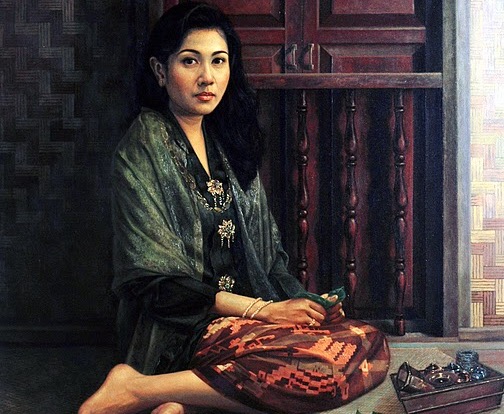Tun Fatimah

Tun Fatimah was a well-known heroine and daughter of Tun Mutahir the Malaccan bendahara who lived during the 16th century. She was married to Malacca's Sultan Mahmud Shah.
Early Life
Fatimah was the descendant of Tun Kudu and Tun Ali's marriage. Both were pominent figures in the times of Sultan Muzaffar Shah, the fifth Sultan of Malacca. Tun Kudu was initially married ti Sultan Muzaffar, who divorced her so that she could marry Tun Ali. Only then would Tun Ali step down from his position as Prime Minister for the more effective Tun Perak, Tun Kudu's brother, to take his place. According to Sejarah Melayu.
First Marriage To Tun Ali
Tun Fatimah was already married to another influential young member of her clan, Tun Ali (not to be confused with her ancestor) when Sultan Mahmud set his sights on her to become his new wife. It is said that the Sultan was upset that Tun Mutahir kept the fact that he had a beautiful daughter away from the sultan and married her off to someone else. To add to the problem, many of the Sultan's courtiers felt alienated with Tun Mutahir who elected members of his clan to important posts in the Malaccan government. One of these courtiers was Raja Mudaliar, the Syahbandar (Chief of Port) of Malacca allegedly start a rumour that Tun Mutahir was scheming to take over the throne. Tun Fatimah refused to divorce her husband when the Sultan's courtiers urged ger. This proved to be her ultimate undoing because it led to the execution of all her male relatives in her family, including her father, Tun Mutahir and also her first husband, Tun Ali.
Second Marriage To Sultan Mahmud
Tun Fatimah finally complied with the Sultan's wishes. She became his fifth wife. During her time as the royal consort, Tun Fatimah was said ti have never smiled, and miscarried three times, perhaps due to emotional misery or even as a silent way or exacting revenge for the injustices committed by the Sultan against her family. She only started bearing children when the Sultan guaranteed her son will succeed him as ruler of Malacca. Fatiamh eventually bore the Sultan two Princes and two Princesses. Mahmud had his eldest son, Ahmad Shah, with his first wife Tun Teja, who succeeded him while Fatimah's sons were still minors.
Role As Queen Of Malacca
As queen consort, Tun Fatimah made sure those who slandered her father and family were executed. SHe then went on to become the first Malay woman to lead her people like a charismatic sovereign queen. It is said that the Portuguese were more afraid of the Queen than her reigning Sultan husband. He was known to help the army to lead the Malays in their fight against the invading Portuguese forces in the early 16th century. Unfortunately, the Malays had later lost the war to the Portuguese army. According to the Malaysian historians it was a sly foreign Datuk of Malacca who gave out the secrets to them to conquer the city, and thus had eventually made the Mlaays lost their control of it. Perhaps the fall of Malacca is also partly due to the Sultan's cruelty.
Post Fall Of Malacca
Ahamd Shah was deemed incompetent and was killed by Mahmud Shah himslef in 1513 after a fail attempt to retake Malacca from the Portuguese Mahmud Shah then reclaimed the throne, although by then the Malacca Sultanate hab been abolished thus making him a pretender. Fatimah's eldest son, Muzaffar Shah went on to establish a Sultanate in Perak region while her second son, Raja Raden Ali went on to become the second ruler of Johor Sultanate as Sultan Alauddin Riayat Shah for 36 years. After Malacca fell to Portugal 1511, it seemed taht it was aminly Tun Fatimah's work that expanded the new Malay Johor-Riau from Johor and Riau islands to parts of Sumatra and Borneo. The Malaccan Sultan's power was almost restricted to a figurehead. Tun Fatimah created an alliance with neighbouring kingdoms by letting her children marry the royal families of Aceh, Minangkabau and Borneo. No one knows how long she had lived for, as well as when and where she died. However, fellow historians of the Malay Archipelago suggested that her tombstone is located in Kampar, Riau on the indonesian island of Sumatra.






